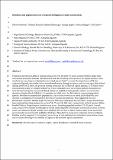Files in this item
Densities and population sizes of raptors in Uganda’s conservation areas
Item metadata
| dc.contributor.author | Pomeroy, Derek | |
| dc.contributor.author | Kibuule, Micheal | |
| dc.contributor.author | Nalwanga, Dianah | |
| dc.contributor.author | Kaphu, George | |
| dc.contributor.author | Opige, Michael | |
| dc.contributor.author | Shaw, Philip | |
| dc.date.accessioned | 2020-01-16T00:37:45Z | |
| dc.date.available | 2020-01-16T00:37:45Z | |
| dc.date.issued | 2019-01-16 | |
| dc.identifier | 255748610 | |
| dc.identifier | 6c458f9e-0a28-45bb-9547-86aa5d5cfa20 | |
| dc.identifier | 85060180204 | |
| dc.identifier | 000461589300005 | |
| dc.identifier.citation | Pomeroy , D , Kibuule , M , Nalwanga , D , Kaphu , G , Opige , M & Shaw , P 2019 , ' Densities and population sizes of raptors in Uganda’s conservation areas ' , Ostrich , vol. 90 , no. 1 , pp. 25-36 . https://doi.org/10.2989/00306525.2018.1508083 | en |
| dc.identifier.issn | 0030-6525 | |
| dc.identifier.other | ORCID: /0000-0002-8183-0289/work/143336060 | |
| dc.identifier.uri | https://hdl.handle.net/10023/19294 | |
| dc.description.abstract | Projected increases in Africa’s human population over the next 40 years point to further, large-scale conversion of natural habitats into farmland, with far-reaching consequences for raptor species, some of which are now largely restricted to protected areas (PAs). To assess the importance of PAs for raptors in Uganda, we conducted an annual road survey through savanna, pastoral and agricultural land during 2008–2015. Here, we present density estimates for 34 diurnal raptor species, 18 of which were encountered largely or entirely within PAs. These included seven out of eight globally threatened or near-threatened species surveyed. Based mainly on published demographic values, we converted density estimates (birds 100 km-2) to numbers of adult pairs, for 11 resident, savanna-dependent species. We then estimated adult population sizes within conservation areas (individual PAs and clusters of contiguous PAs), based on the area of savanna in each site. This suggested that two threatened residents, Martial Eagle Polemaetus bellicosus and Lappet-faced Vulture Torgos tracheliotos, have national breeding populations of just 90–120 pairs. A third, White-headed Vulture Trigonoceps occipitalis, may have a breeding population of just 22–32 pairs. In each case, at least 90% of pairs are thought to reside within Uganda’s five largest conservation areas. In three cases our estimates of pair density were markedly lower than in other studies, while in six cases they were broadly consistent with published findings, derived from more intensive survey methods. Further work is required to determine the accuracy of our estimates for individual conservation areas, and to assess the long-term viability of Uganda’s threatened raptor populations. | |
| dc.format.extent | 12 | |
| dc.format.extent | 1288005 | |
| dc.language.iso | eng | |
| dc.relation.ispartof | Ostrich | en |
| dc.subject | African raptors | en |
| dc.subject | Vultures | en |
| dc.subject | Eagles | en |
| dc.subject | Raptor abundance | en |
| dc.subject | Protected areas | en |
| dc.subject | Savanna | en |
| dc.subject | QH301 Biology | en |
| dc.subject | NDAS | en |
| dc.subject | SDG 15 - Life on Land | en |
| dc.subject.lcc | QH301 | en |
| dc.title | Densities and population sizes of raptors in Uganda’s conservation areas | en |
| dc.type | Journal article | en |
| dc.contributor.institution | University of St Andrews. School of Biology | en |
| dc.identifier.doi | https://doi.org/10.2989/00306525.2018.1508083 | |
| dc.description.status | Peer reviewed | en |
| dc.date.embargoedUntil | 2020-01-16 |
This item appears in the following Collection(s)
Items in the St Andrews Research Repository are protected by copyright, with all rights reserved, unless otherwise indicated.

